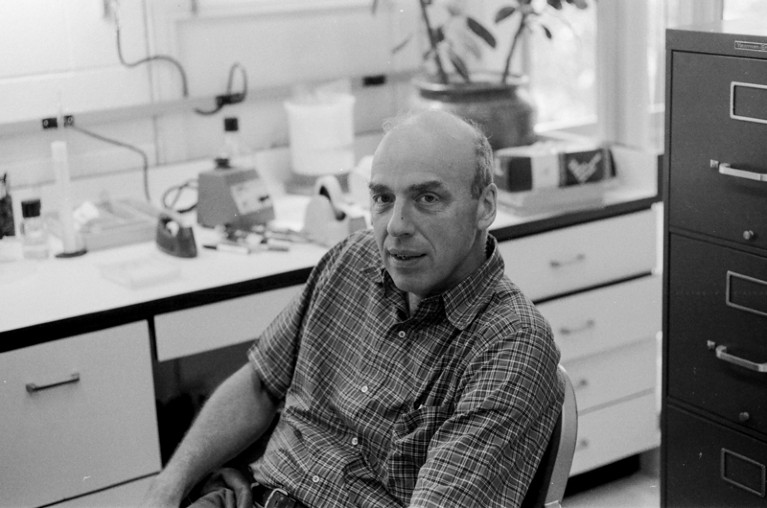
Credit: Carnegie Institution for Science
Don Brown’s experiments revolutionized our understanding of how a fertilized egg develops into the adult organism. His research at the interface of molecular biology, embryology and biochemistry was seminal in shifting the focus of developmental biology from anatomical observations through microscopes to mechanistic studies of genes and their regulation. Brown’s early work on isolated genes led to the advent of recombinant DNA — when it became possible to directly modify the genes of organisms. It also provided the foundation for targeted genetic engineering.
Born in Cincinnati, Ohio, Brown did an undergraduate degree at Dartmouth College in Hanover, New Hampshire, and medical and master’s degrees at the University of Chicago Medical School in Illinois. He chose a career in research after a journal-club discussion of James Watson and Francis Crick’s classic 1953 Nature paper on the structure of DNA. Fascinated by how embryos develop, Brown decided to focus on the role of DNA in development.
After a year as an intern at Charity Hospital in New Orleans, Louisiana, and two years at the National Institutes of Health in Bethesda, Maryland, Brown spent a formative year at the Pasteur Institute in Paris studying gene regulation in bacteria. This was where the field of molecular biology was being born; and he was stimulated by lunchtime discussions led by future Nobel laureates Jacques Monod, François Jacob and André Lwoff.
EU proposal on CRISPR-edited crops is welcome — but not enough
In 1961, Brown returned to the United States and joined the Carnegie Institution’s Department of Embryology in Baltimore, Maryland, as its first biochemist. He stayed there until he retired in 2005, acting as its director from 1976 to 1994, during which time the department became world-renowned.
At Carnegie, he decided to explore the molecular basis of embryo development, using the African clawed frog (Xenopus laevis). In the first step of gene expression, segments of DNA are copied through transcription to produce RNA. In the next step, ribosomes (containing ribosomal RNA, rRNA) serve as the cellular factories for synthesizing proteins. Together with British developmental biologist John Gurdon, Brown found that a Xenopus mutant lacking nucleoli (spherical structures inside the cell’s nucleus) neither made rRNA nor had rRNA genes — and therefore that the nucleolus makes the rRNA component of ribosomes.
He also deduced that healthy Xenopus eggs (oocytes) in the ovary that have thousands of nucleoli have extra copies of rRNA genes. This discovery of ‘gene amplification’ was published in a seminal paper in 1968 (D. D. Brown and I. B. Dawid Science 160, 272–280; 1968); US cell biologist Joseph Gall reported a similar result independently the same year. The finding challenged the idea that all the cells of an organism have a constant amount of DNA. It is now also appreciated that gene amplification can be a hallmark of cancer. Brown’s 1968 work involved gene isolation before the days of DNA cloning, and the massive amount of amplified rRNA genes from Xenopus oocytes was purified through centrifugation. This was the first time a gene had been purified, and others used this material to clone the first eukaryotic gene, thus launching the recombinant-DNA era.
Next, Brown explored the regulation of gene activity for another component of the ribosome: 5S RNA. In 1979, he attended the Gordon conference on Developmental Biology in Andover, New Hampshire to present his findings. At the opening social event, word about Brown’s results spread like wildfire. By the time he gave his talk a few days later, everyone in the audience already knew the punchline — gene activity was controlled by an ‘internal control region’ that lay in the middle of the 5S RNA gene, not before the gene as had been expected.
Soon afterwards, a protein was found that bound to the internal control region of the 5S RNA gene. This was the inaugural example of a ‘gene-specific transcription factor’. Robert Roeder, who had previously done a postdoc with Brown, purified, cloned and sequenced it. In subsequent studies by British biophysicist Aaron Klug, the factor also became the first example of a ‘zinc finger protein’ — in which zinc is bound to a stretch of amino acids.
The ability to engineer zinc finger proteins so they bind to specific genes ushered in the first wave of the genome-editing revolution two decades ago. Targeted genetic engineering, now widely practised using CRISPR–Cas nucleases, owes a formidable debt to Brown’s work.
Don’s final studies were on amphibian metamorphosis. His identification of genes controlled by thyroid hormone provided insight into the hormonal control of organ development, cell growth and programmed cell death.
Don was a scientific leader. He received the 2012 Lasker–Koshland Special Achievement Award, organized the first Developmental Biology Gordon Conference in 1970 and was president of the US Society for Developmental Biology and the American Society for Cell Biology (ASCB). He was committed to young scientists and founded and led the Life Sciences Research Foundation, which awards postdoctoral fellowships in the United States.
Don had a bottom-up and democratic view of leadership. He published profiles of researchers in the ASCB newsletter to make everyone feel part of the society ‘family’. He was a great administrator, being straightforward, honest and approachable. He was a humble man with a great sense of humour. Don was a wonderful person who inspired the scientific community through his research, his leadership and his mentorship of the rising generation. He will be missed.


 EU proposal on CRISPR-edited crops is welcome — but not enough
EU proposal on CRISPR-edited crops is welcome — but not enough
 What Rosalind Franklin truly contributed to the discovery of DNA’s structure
What Rosalind Franklin truly contributed to the discovery of DNA’s structure
 Paul Berg (1926–2023)
Paul Berg (1926–2023)
 Why CRISPR babies are still too risky — embryo studies highlight challenges
Why CRISPR babies are still too risky — embryo studies highlight challenges
 The mice with two dads: scientists create eggs from male cells
The mice with two dads: scientists create eggs from male cells







